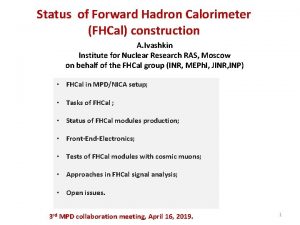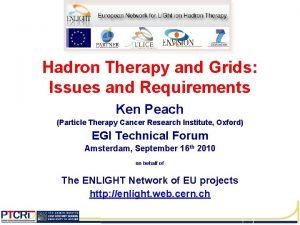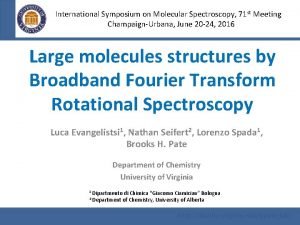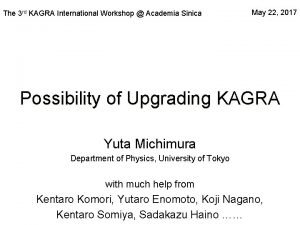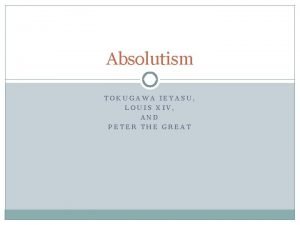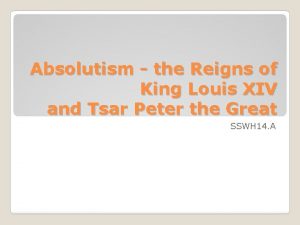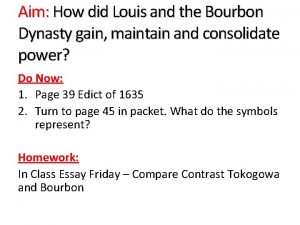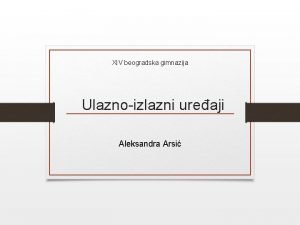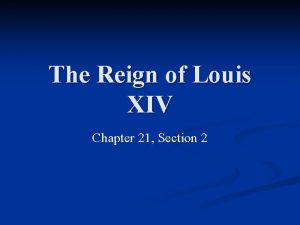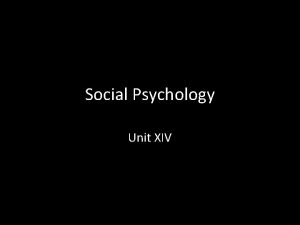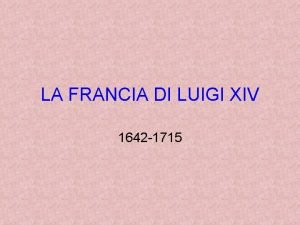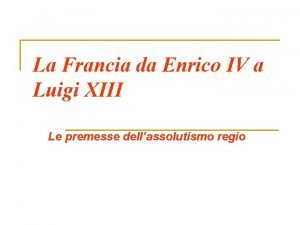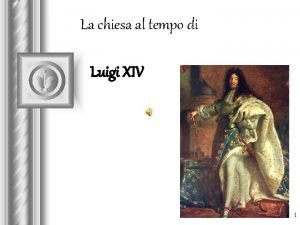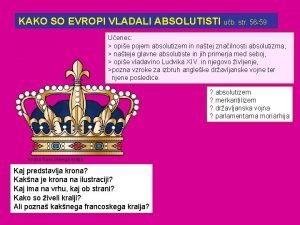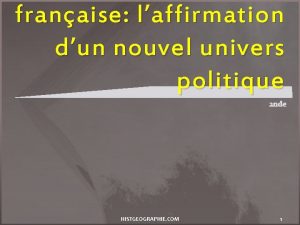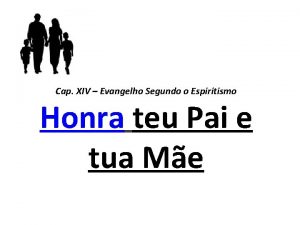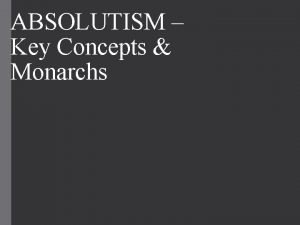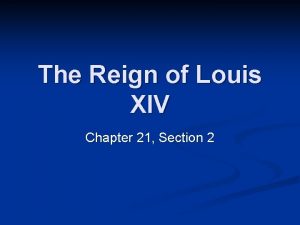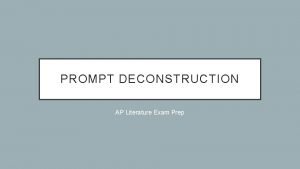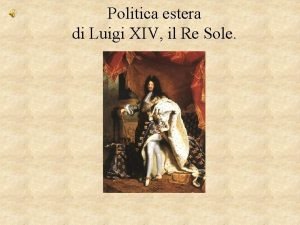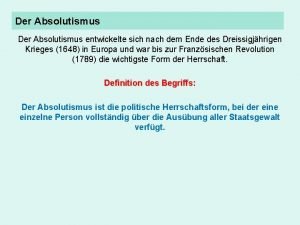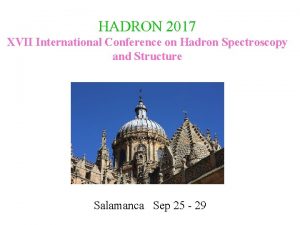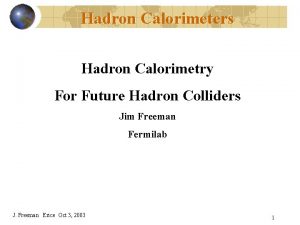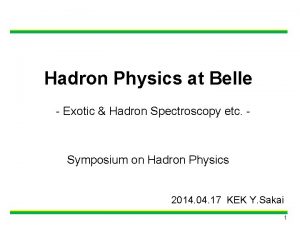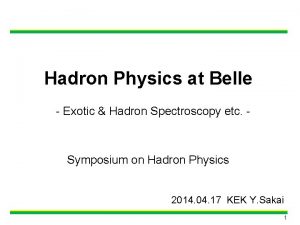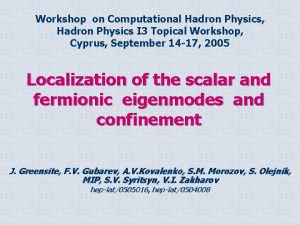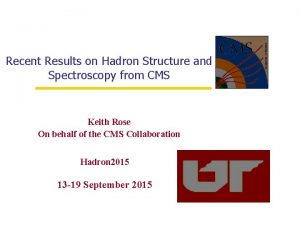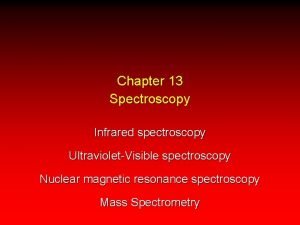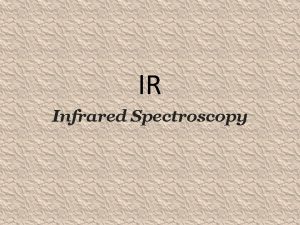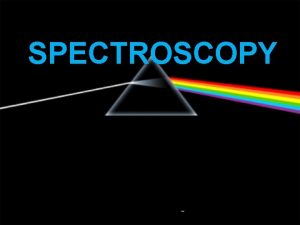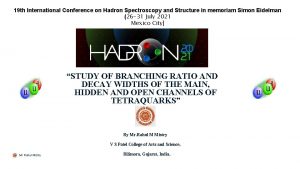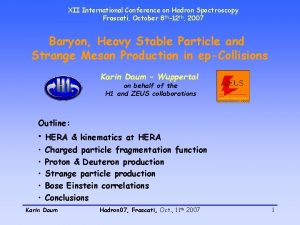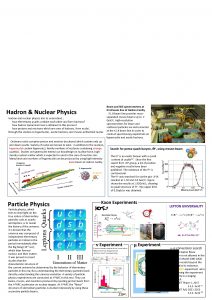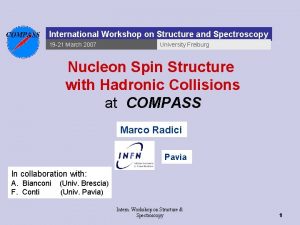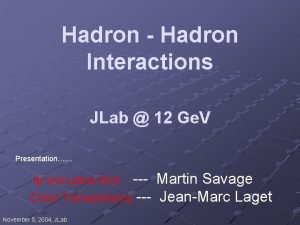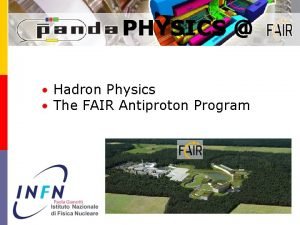XIV International Workshop on Hadron Structure and Spectroscopy














![Electron production M 2: Momentum e- fraction [ [Ge. V/c] %] 50 30 100 Electron production M 2: Momentum e- fraction [ [Ge. V/c] %] 50 30 100](https://slidetodoc.com/presentation_image_h/a54fdb8f18f60e64e9ab938d78bae25e/image-15.jpg)














- Slides: 29

XIV International Workshop on Hadron Structure and Spectroscopy Cortona (Italy), 2 - 5 April 2017 RF-separated beams and “Physics Beyond Colliders” Johannes BERNHARD (CERN EN-EA), Lau GATIGNON (CERN EN-EA) 03. 04. 2017

Agenda • The “Physics beyond Colliders” Initiative • Particle production and beam composition • Enrichment of particle species in beams • Considerations for RF-separated beams http: //pbc. web. cern. ch/ J. Bernhard RF separated beams and "Physics Beyond Colliders" 2

Physics Beyond Colliders – Introduction • Extrapolary study aimed at exploiting the full scientific potential of CERN's accelerator complex and its scientific infrastructure through projects complementary to the LHC, HL-LHC and other possible future colliders • Projects targeting fundamental physics questions that are similar in spirit to those addressed by high-energy colliders, but that require different types of beams and experiments • Initiated by CERN director-general and coordinated by J. Jaeckel, M. Lamont and C. Vallee • Kick-off workshop (September 2016) identified a number of areas of interest • Working groups set-up to pursue studies in these areas • PBC study remains open to further ideas for new projects J. Bernhard RF separated beams and "Physics Beyond Colliders" 3

Physics Beyond Colliders – Introduction Physics Groups • BSM subgroup: SHIP; NA 64++; NA 62++; KLEVER; IAXO; LSW; EDM • QCD subgroup: COMPASS++; μ-e; LHC FT (gas target + crystal extraction); DIRAC++; NA 60++; NA 61++ Deliverables: • Evaluation of the physics case in the worldwide context • Possible further detector optimization • For new projects: investigation of the uniqueness of the CERN accelerator complex for their realization J. Bernhard RF separated beams and "Physics Beyond Colliders" 4

Accelerator Working Group J. Bernhard RF separated beams and "Physics Beyond Colliders" 5

Physics Beyond Colliders – Introduction • Conventional beams subgroup: Evaluation of NA 62 beam dump, COMPASS RF separated beam, NA 61++ beam, KLEVER beam + possible siting of NA 64++, μ-e elastic experiment, NA 60++, and DIRAC++ beams • BDF subgroup: Completion of technical feasibility studies of a Bump Dump Facility as input to the SHi. P conceptual design study (CDS) • EDM subgroup: Feasibility study including preliminary costing • LHC Fixed Target subgroup: Collection of various initiatives (UA 9, LHC collimation team, AFTER collaboration) with the aim of a conceptual design report • Technology subgroup: Evaluation of possible technological contributions of CERN to non-accelerator projects possibly hosted elsewhere J. Bernhard RF separated beams and "Physics Beyond Colliders" 6

Conventional Beams – Strategy • Large number of fixed target proposals • Pre-proposal studies for working groups to ensure progress with their evaluation • Focus first on projects with • Possible short and medium time-scale implementation • Limited resources • Most advanced and competitive (based on the available input and first feasibility analysis regarding the FT implementation) • Additional studies based on the information provided by the collaborations and the following criteria: • Analysis of the physics WG • Sufficient details known that are required for an implementation study • Study can be performed within the timescale of the European Strategy update J. Bernhard RF separated beams and "Physics Beyond Colliders" 7

Conventional Beams – Projects Under consideration at present: • NA 62: Proposal to operate in beam-dump mode • NA 64++: High intensity electron, muon and hadron beams for dark particles searches • KLEVER: High intensity KL beam (high flux, pencil beam, new target) for rare decays • COMPASS++: RF separated beams for hadron structure and spectroscopy • μ-e: 150 Ge. V muon beams for high precision measurement of hadron vacuum polarisation for g-2 of the muon • DIRAC++: DIRAC@SPS for high statistic mesonic atoms • NA 60++: Heavy ion beams for di-muon physics • NA 61++: Higher intensity ion beam for charm studies J. Bernhard RF separated beams and "Physics Beyond Colliders" 8

Conventional Beams – Structure CONVENTIONAL BEAMS WORKING GROUP Conveners: L. Gatignon, M. Brugger Members: Experiments, H. Wilkens, G. Lanfranchi, T. Spadaro, EA physicists, HSE, RP, EL, CV, RF, STI CBWG-ECN 3 • • KLEVER NA 62 Dump NA 60 DIRAC CBWG-EHN 2 • COMPASS (RF-separated and low energy pbar beams) • μ-e elastic • NA 64 -μ • CEDAR J. Bernhard CBWG-EHN 1 • NA 64 hadrons RF separated beams and "Physics Beyond Colliders" 9

Conventional Beams – Structure CONVENTIONAL BEAMS WORKING GROUP Conveners: L. Gatignon, M. Brugger Members: Experiments, H. Wilkens, G. Lanfranchi, T. Spadaro, EA physicists, HSE, RP, EL, CV, RF, STI CBWG-ECN 3 CBWG-EHN 2 CBWG-EHN 1 Members: EA physicists, RP, HSE, CV, EL, MPE, STI, MSC, EPC, SMB Members: EA physicists, RP, HSE, RF, CV, EL, STI, MSC, EPC, CRG, SMB Members: EA physicists, RP, HSE, CV, EL, MSC, EPC J. Bernhard RF separated beams and "Physics Beyond Colliders" 10

Conventional Beams Successful kick-off meeting February 22 nd J. Bernhard RF separated beams and "Physics Beyond Colliders" 11

Particle production Atherton parameterisation (CERN 80 -07): with primary momentum p 0 and production angle q Flux per solid angle [steradian], per interacting proton, and per dp [Ge. V/c] J. Bernhard RF separated beams and "Physics Beyond Colliders" 12

Particle production Atherton parameterisation (CERN 80 -07): with primary momentum p 0 and production angle q Flux per solid angle [steradian], per interacting proton, and per dp [Ge. V/c] q = 0 mrad J. Bernhard RF separated beams and "Physics Beyond Colliders" 13

Particle production – pbar case q = 0 mrad Best case for flux: about 50 Ge. V/c • 0. 77 pbar / interacting proton / steradian / Ge. V • 3. 2% of the total negative hadron flux • Warning: many electrons at low energies! J. Bernhard RF separated beams and "Physics Beyond Colliders" 14
![Electron production M 2 Momentum e fraction Ge Vc 50 30 100 Electron production M 2: Momentum e- fraction [ [Ge. V/c] %] 50 30 100](https://slidetodoc.com/presentation_image_h/a54fdb8f18f60e64e9ab938d78bae25e/image-15.jpg)
Electron production M 2: Momentum e- fraction [ [Ge. V/c] %] 50 30 100 8 200 0. 7 J. Bernhard Monte Carlo for e- production: • Process po = (p+ + p-)/2 , po gg • x=Ee/Eg with f(x)=x 2+(1 -x)2+2 x(1 -x)/3 Extrapolation from West Area experience: • e- about 8% of beam at -120 Ge. V/c (q = 0 mrad) Possible reduction: • Thin Pb sheet • Drawback: affects parallelism at CEDARs RF separated beams and "Physics Beyond Colliders" 15

Beam composition Example: p = -100 Ge. V/c (Kaons and electrons at similar fractions) Particle type Fraction at T 6 Fraction at COMPASS pbar 1. 7 % 2. 1 % K- 5. 8 % 1. 6 % p- 84. 5 % 86. 3 % e- 8. 0 % 10. 0 % • Present M 2 hadron beam: ≤ 2 106 pbar due to 108 / 10 s spill limit on total beam flux for RP • Drell-Yan configuration: < 107 pbar (for 5 108 total flux) J. Bernhard RF separated beams and "Physics Beyond Colliders" 16

Enrichment of particle species – I Differential absorption: • Beam through filter • Enrichment = single particle attenuation ai over total beam attenuation Example: +300 Ge. V/c beam filtered with 3 m polyethylene • Initial flux 5 108 particles Particles % initial beam % filtered beam Flux Protons 92. 5 73. 4 7. 9 106 Pions 5. 8 19. 1 2. 1 106 Kaons 1. 7 7. 5 8 105 • Drawbacks: • Small suppression factor for unwanted particles • Big losses with low efficiency J. Bernhard RF separated beams and "Physics Beyond Colliders" 17

Enrichment of particle species – II Electrostatic separation: • Beam traverses electric field coupled to magnetic fields at the ends • Separation for particle species 1 and species 2 • Unwanted particles dumped on collimators • Drawbacks: • Separation only for very low momenta • Chromatic aberrations J. Bernhard RF separated beams and "Physics Beyond Colliders" 18

RF-separated beams Note: Preliminary considerations, guided by initial studies for P 326 and CKM studies by J. Doornbos/TRIUMF Panofsky-Schnell-System with two cavities (CERN 68 -29): • • Particle species have same momenta but different velocities Time-dependent transverse kick by RF cavities in dipole mode RF 1 kick compensated or amplified by RF 2 Selection of particle species by selection of phase difference DF = 2 p (L f / c) (b 1 -1 – b 2 -1) J. Bernhard RF separated beams and "Physics Beyond Colliders" 19

How to choose phases? DF = 2 p (L f / c) (b 1 -1 – b 2 -1) For large momenta: b 1 -1 – b 2 -1 = (m 12 -m 22)/2 p 2 For K± beams: DFpp = 360 o and FRF 2 such that both p and p go straight i. e. dumped DFp. K = 94 o, i. e. a good fraction of K outside the dump, depending on phase at 1 st cavity For pbar beams: DFpp = 180 o and then DFpe = 184 o , DFp. K = 133 o with phase of RF 2 such that pions go straight, antiprotons get reasonable deflection, electrons are dumped effectively and K reduced Note: pbar may arrive at any phase w. r. t. the RF signal Losses! J. Bernhard RF separated beams and "Physics Beyond Colliders" 20

Example DF = 2 p (L f / c) (b 1 -1 – b 2 -1) For large momenta: b 1 -1 – b 2 -1 = (m 12 -m 22)/2 p 2 RF 1 DUMP L Momentum selection Use input from CKM studies • Kick: 15 Me. V/c • f = 3. 9 GHz • dp/p = 2% • Dfpp = p (pbar selection) / Dfpp = 2 p (K selection) J. Bernhard RF separated beams and "Physics Beyond Colliders" 21

Example DF = 2 p (L f / c) (b 1 -1 – b 2 -1) For large momenta: b 1 -1 – b 2 -1 = (m 12 -m 22)/2 p 2 J. Bernhard RF separated beams and "Physics Beyond Colliders" 22

Example DF = 2 p (L f / c) (b 1 -1 – b 2 -1) For large momenta: b 1 -1 – b 2 -1 = (m 12 -m 22)/2 p 2 About 900 m between cavities for -100 Ge. V/c pbars J. Bernhard RF separated beams and "Physics Beyond Colliders" 23

Example • Phase shift depends on square momentum: Separation only over very limited momentum range for one particle species • Dispersion: DFfinal = DFinitial (1 – 2 Dp/p) • Limits Dp/p to about 1 % 18 Ge. V/c 90 o J. Bernhard RF separated beams and "Physics Beyond Colliders" 24

Coherence length of cavity Another example: f = 3. 9 GHz • RF wavelength l = c/f = 3 1010 cm s-1 / 3. 9 109 s-1 = 7. 5 cm • Coherence length (“phase is sufficiently preserved”, Df p/10) Lcoh l. (p/10) / (2 p) 4 mm Beam spot has to remain within ± 1. 5 mm throughout the cavity • pt-kick 15 Me. V/c (see CKM system), i. e. 0. 15 mrad at 1 o 0 Ge. V • Beam divergence must be smaller than this in the bending plane • Non-bending plane: sufficiently small divergence, e. g. ± 0. 5 mrad • Conclusion: RF system limits transverse emittance J. Bernhard RF separated beams and "Physics Beyond Colliders" 25

Acceptance values Note: rough estimate, based on extrapolation from J. Doornbos CKM K+ beam pbar beam Beam momentum [Ge. V/c] 60 100 Momentum spread [%] ± 2 ± 1 ± 3. 5, ± 2. 5 10 -12 p 37 20 Angular emittance H, V [mrad] Solid angle [msterad] % wanted particles lost on stopper Estimation by Lau: As the pbar kick is more favorable than for K+, assume that 80% of p bar pass beyond the beam stopper Acceptance 10 p msterad, 2 Ge. V/c J. Bernhard RF separated beams and "Physics Beyond Colliders" 26

Summary of exercise for p = -100 Ge. V/c • Atherton parameterisation: 0. 42 pbar / int. proton / Ge. V / steradian • Solid angle p. 10 -5 • Assume target efficiency of 40% and 1013 ppp on target • Assume 80% wanted particles pass dump • Assume 2% momentum bite Particle flux: 0. 4. 1013. 0. 42. p. 10 -5. 2. 0. 8 pbar = 8 107 pbar/pulse • Note: e- and p are well filtered, but K+ only partly • For RP limit of 108 on total flux, max antiproton flux limited by purity (probably about 50%), hence 5 107 pbar per pulse • K+ flux: reduced by factor 1. 6 / 2. 1 ~0. 75 (see before) J. Bernhard RF separated beams and "Physics Beyond Colliders" 27

Summary http: //pbc. web. cern. ch/ RF-separated beams • Increase the beam content of wanted particles • Reduce the required overall beam intensity (less radiation) Complex and detailed study needed in the framework of “Physics Beyond Colliders” – Conventional Beams WG • Examples: refine principle (3 cavity design? ), optics, technology survey (RF, CRG, …), radiation protection, expected purity, muon backgrounds, beam instrumentation / particle ID, integration in existing tunnel, etc. • Work will be organised within the CBWG – EHN 2 subgroup J. Bernhard RF separated beams and "Physics Beyond Colliders" 28

Thank you!
 Hadron calorimeter
Hadron calorimeter Hadron collider
Hadron collider Hadron collider
Hadron collider Lhc tantalizing new physics
Lhc tantalizing new physics Hadron
Hadron International symposium on molecular spectroscopy
International symposium on molecular spectroscopy Kagra international workshop
Kagra international workshop Louis xiv and peter the great venn diagram
Louis xiv and peter the great venn diagram Louis xiv and peter the great venn diagram
Louis xiv and peter the great venn diagram Absolutism louis xiv
Absolutism louis xiv How did shang rulers consolidate and enforce their power?
How did shang rulers consolidate and enforce their power? Xv gimnazija zagreb
Xv gimnazija zagreb Imagen 12
Imagen 12 Chapter 21 section 2 the reign of louis xiv
Chapter 21 section 2 the reign of louis xiv Unit xiv social psychology
Unit xiv social psychology Ludvik xiv
Ludvik xiv Madre luigi xiv
Madre luigi xiv Officiers luigi xiv
Officiers luigi xiv Richerismo
Richerismo Monumento a maria cristina d'austria
Monumento a maria cristina d'austria Absolutisti
Absolutisti Louis xiv baroque
Louis xiv baroque Louis xiv en costume de sacre symboles
Louis xiv en costume de sacre symboles Cap xiv evangelho segundo espiritismo
Cap xiv evangelho segundo espiritismo Why was louis xiv called the sun king
Why was louis xiv called the sun king Amore e psiche (david)
Amore e psiche (david) Chapter 21 section 2 the reign of louis xiv
Chapter 21 section 2 the reign of louis xiv Ap literature frq
Ap literature frq Politica estera luigi xiv
Politica estera luigi xiv Slidetodoc.com
Slidetodoc.com
